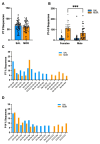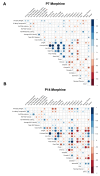This is a preprint.
The acoustic properties, syllable structure, and syllable sequences of ultrasonic vocalizations (USVs) during neonatal opioid withdrawal in FVB/N mouse substrains
- PMID: 39574631
- PMCID: PMC11580921
- DOI: 10.1101/2024.11.06.622304
The acoustic properties, syllable structure, and syllable sequences of ultrasonic vocalizations (USVs) during neonatal opioid withdrawal in FVB/N mouse substrains
Update in
-
The acoustic properties, syllable structure, and syllable sequences of ultrasonic vocalizations (USVs) during neonatal opioid withdrawal in FVB/N mouse substrains.Addict Neurosci. 2025 Sep;16:100215. doi: 10.1016/j.addicn.2025.100215. Epub 2025 Jun 15. Addict Neurosci. 2025. PMID: 40948693 No abstract available.
Abstract
Concomitant with the opioid epidemic, there has been a rise in pregnant women diagnosed with opioid use disorder and cases of infants born with neonatal opioid withdrawal syndrome (NOWS). NOWS refers to signs and symptoms following cessation of prenatal opioid exposure that comprise neurological, gastrointestinal, and autonomic system dysfunction. A critical indicator of NOWS severity is excessive, high-pitched crying. However, NOWS evaluation is, in large part, subjective, and additional cry features may not be easily recognized during clinical assessment. Thus, there is a need for more objective measures to determine NOWS severity. We used a third trimester-approximate opioid exposure paradigm to model NOWS traits in genetically similar inbred substrains of FVB/N mice (NJ, NCrl, NHsd, and NTac). Pups were injected twice daily from postnatal day 1 (P1) to P14 with morphine (10 mg/kg, s.c.) or saline (20 ml/g, s.c.). Because there were only very minor substrain differences in spontaneous withdrawal-induced ultrasonic vocalization (USV) profiles, we collapsed across substrains to evaluate the effects of morphine withdrawal on additional USV properties. We identified syllable sequences unique to morphine-withdrawn and saline-control FVB/N pups on P7 and P14. We also observed an effect of spontaneous morphine withdrawal on the acoustic properties of USVs and specific syllables on P7 and P14. Multiple withdrawal traits correlated with some acoustic properties of USVs and syllable type emission in morphine-withdrawn FVB/N pups on P7 and P14. These data provide an in-depth investigation of mouse USV syllable profiles and acoustic features during spontaneous neonatal opioid withdrawal in mice.
Keywords: emotional-affective withdrawal; morphine; mouse substrains; neonatal opioid withdrawal syndrome; spectrotemporal profile; ultrasonic vocalizations.
Conflict of interest statement
Competing Interests The authors have nothing to disclose.
Figures






References
-
- Desai R.J., Huybrechts K.F., Hernandez-Diaz S., Mogun H., Patorno E., Kaltenbach K., Kerzner L.S., Bateman B.T., Exposure to prescription opioid analgesics in utero and risk of neonatal abstinence syndrome: population based cohort study, The BMJ 350 (2015) h2102. 10.1136/bmj.h2102. - DOI - PMC - PubMed
Publication types
Grants and funding
LinkOut - more resources
Full Text Sources
Research Materials
